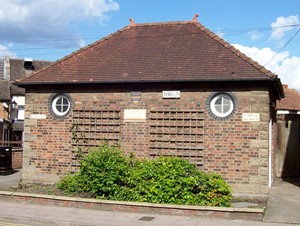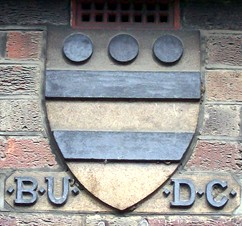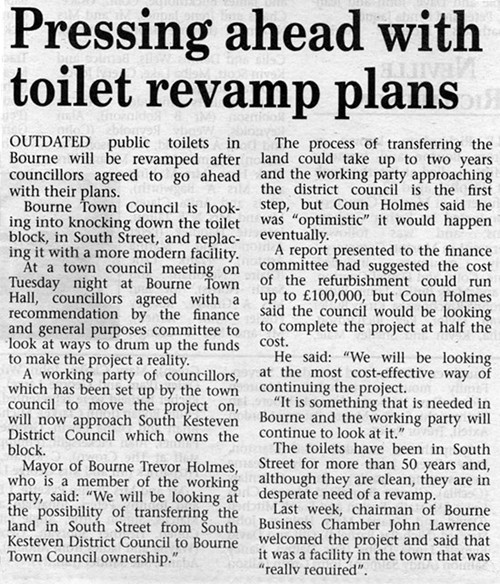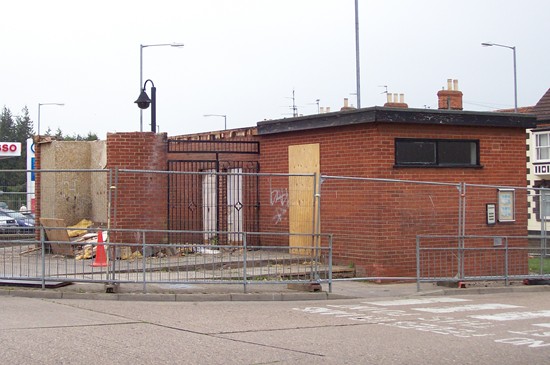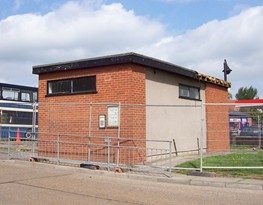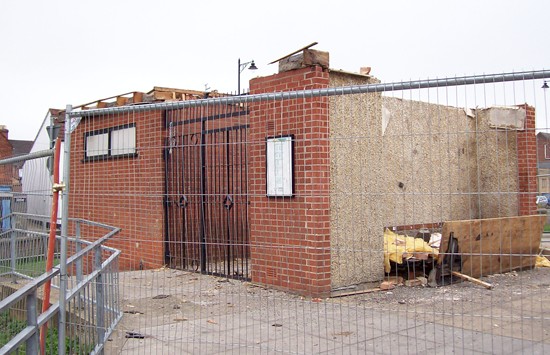|
Public lavatories South Street is the home of Bourne's most inglorious building containing the town's public lavatories. They were erected by the former Bourne Urban District Council circa 1948 but because of continued subsequent neglect, they became dark, dirty and vandalised and often without even running water in some of the more important facilities. It also became a forbidding place to visit after dark.
The deterioration had started forty years later and in 1970, Councillor Derek Ward told a meeting of Bourne Urban District Council that better facilities were badly needed in the interests of public health and hygiene and his views were endorsed by the Medical Officer of Health, Dr H Ellis-Smith. Councillor Mrs Marjorie Clark, chairman of the estates committee, replied that provision would be made in the 1971 budget for a higher standard of hygiene at the toilets and added: "We have had to cut the estimates for this year down to a minimum. It will cost quite a bit of money to provide sinks while soap and towels will disappear like magic and this will cause something of a nightmare for us."
Improvement work costing £11,000 was carried out in 1982 when
Councillor Don Fisher told South Kesteven District Council’s environmental
health committee: “It seems that many vandal-proof precautions have been taken
and the facilities for the handicapped are to be applauded.”
The improvements were short-lived because the building again
began to show signs of neglect and by 2002, South Kesteven District Council
which had taken over responsibility for the amenity in 1974, decided that the
lavatories should be closed. Spot checks had been carried out by the council
revealing serious vandalism and offensive graffiti and officers decided to shut
the building until it was cleaned and repaired although the Stamford Mercury
claimed on October 4th that the toilets had been closed because of the
activities of paedophiles and they quoted cabinet member, Councillor Peter
Martin-Mayhew, who had taken part in the checks, as saying: "The things I saw
were absolute filth and included posters, pamphlets, names of schools and
children. This is a wake up call for us as a council to decide whether we wish
to continue funding public toilets which are degenerating into dens for
homosexuals and paedophiles to operate." No evidence was produced to support these allegations but the lavatories were eventually closed later that month when the council admitted that the provision of public loos was a discretionary service which they were not duty bound to provide but the loss of the loos resulted in a public outcry. To compound this error, Councillor Martin-Mayhew caused another furore the following month by advising anyone needing to spend a penny to use the lavatories in the town centre public houses instead and this raised the ire of landlords who, The Local said on November 8th, were hopping mad at the thought of subsidising council services in this way and by having shoppers traipsing through to spend a penny but not buy a pint. He then suggested that visitors should use the toilets in the supermarkets and by now, opposition to the closure was so intense that SKDC had no alternative but to back down, eventually coming to an agreement with Bourne Town Council over their future upkeep under which the lavatories were refurbished at a cost of £4,400 and re-opened in April 2004 with jubilant pensioners on hand urging everyone to show their support by going to spend a penny.
By now, it had become apparent that the shutting of public
lavatories was not confined to the Bourne area because the British Toilet Association
revealed in January 2004 that one in five across the country had been closed in
the previous three years and of those that remained, two thirds were open for
fewer than 12 hours a day. The action by SKDC was therefore seen as a concerted
attempt to phase them out but reckoned without such strong public opposition.
Meanwhile, in July that year, the newly opened lavatories were nominated for an award by
the British Toilet Association, the organisation that presents an annual “Loo of
the Year” award to recognise the efforts and achievements of toilet providers
around the country. Bourne resident Barbara Spiller, a marketing advisor to one
of the award sponsors, considered that they merited national recognition. “Most
local authorities choose to solve the problem of public toilet abuse and
vandalism by closing them”, she says, “but this doesn’t help the many people who
need toilets when they are away from home, parents with young children, the
elderly and those with special needs. It is to the town council’s credit that it
has recognised the needs of the community and I felt it should be recognised in
return.” Her enthusiasm, however, was not shared by the association and Bourne
did not get an award. South Kesteven District Council had agreed in principle to provide new lavatories, either by refurbishing the existing ones or by replacing them with a new 36-foot toilet block to be built at the entrance to the market square behind the town hall at a cost of £100,000, a scheme which did not please the market traders because it would reduce the space available for stalls and even deter shoppers. Bourne Town Council was not consulted but a survey among local people showed that the majority wanted new toilets on the South Street site and not on the market place.
Whichever site was chosen, the council had promised that the new loos would have all the latest amenities such as disabled access, a baby changing area and an attendant to ensure that there is not a recurrence of the vandalism that plagued the South Street loos in recent years. But there was a catch because council leader Linda Neal told The Local on Friday 7th February 2003: "The toilet facility will complement any core centre redevelopment. It will be a high quality provision and will be built as soon as it is feasibly possible." The town centre redevelopment was then seven years behind schedule.
The only other public lavatories in Bourne were situated at the bus station in North Street and represent a similar case of local authority neglect, their demolition eventually blamed on vandalism and misuse. They were built when the bus station was developed in 1974 and remained an important amenity for travellers as well as townspeople for the next quarter of a century. Young people did congregate on the outside seats in the evenings and at weekends and there was some damage and graffiti but the only solution that SKDC could offer was to close them down in 2002 and for the next five years, the building was bolted and barred and in April 2007, it was demolished.
The reason was obviously money yet the lame excuse offered by the council was that the building obscured the CCTV cameras in South Street. The work was partly funded by Bourne Town Centre Management Partnership which contributed £10,000. "They have become an unused eyesore", said town centre manager Ivan Fuller, "and will be pulled down and replaced with a hard landscape area with seating and plants. The building has become a focal point for anti-social behaviour including under-age drinking and vandalism. The project has the full support of the local police and will help them monitor anti-social behaviour more easily."
By 2009, the new public lavatories promised by SKDC had been
forgotten but the South Street block was again deteriorating and the town
council agreed that it should be demolished and replaced with a new facility. A
working party was formed to handle the project and to negotiate a legal takeover
of the land in order that the work could go ahead but councillors had second
thoughts and decided that there was sufficient public support to keep them open.
As a result, an agreement was reached between the two authorities that the town
council would run and maintain the lavatories for the time being.
REVISED DECEMBER 2014
See also
New public lavatories will be difficult to find
Go to: Main Index Villages Index |
||||||||||||

